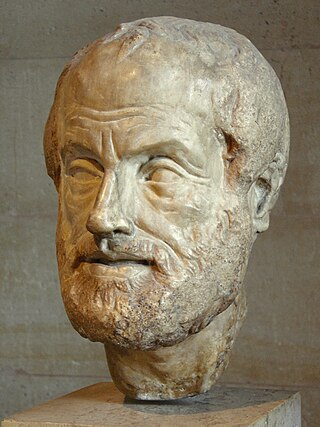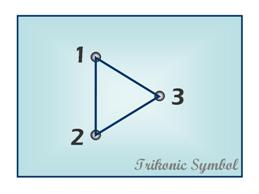Related Research Articles

Charles Sanders Peirce was an American scientist, mathematician, logician, and philosopher who is sometimes known as "the father of pragmatism". According to philosopher Paul Weiss, Peirce was "the most original and versatile of America's philosophers and America's greatest logician". Bertrand Russell wrote "he was one of the most original minds of the later nineteenth century and certainly the greatest American thinker ever".

A sign is an object, quality, event, or entity whose presence or occurrence indicates the probable presence or occurrence of something else. A natural sign bears a causal relation to its object—for instance, thunder is a sign of storm, or medical symptoms a sign of disease. A conventional sign signifies by agreement, as a full stop signifies the end of a sentence; similarly the words and expressions of a language, as well as bodily gestures, can be regarded as signs, expressing particular meanings. The physical objects most commonly referred to as signs generally inform or instruct using written text, symbols, pictures or a combination of these.
Semiotics is the systematic study of sign processes and the communication of meaning. In semiotics, a sign is defined as anything that communicates intentional and unintentional meaning or feelings to the sign's interpreter.
Semiosis, or sign process, is any form of activity, conduct, or process that involves signs, including the production of meaning. A sign is anything that communicates a meaning, that is not the sign itself, to the interpreter of the sign. The meaning can be intentional such as a word uttered with a specific meaning, or unintentional, such as a symptom being a sign of a particular medical condition. Signs can communicate through any of the senses, visual, auditory, tactile, olfactory, or taste.
In semiotics, a sign is anything that communicates a meaning that is not the sign itself to the interpreter of the sign. The meaning can be intentional, as when a word is uttered with a specific meaning, or unintentional, as when a symptom is taken as a sign of a particular medical condition. Signs can communicate through any of the senses, visual, auditory, tactile, olfactory, or taste.
The semiosphere is an idea in biosemiotic theory proposing that, contrary to ideas of nature determining sense and experience, the phenomenal world is a creative and logical structure of processes of semiosis where signs operate together to produce sense and experience.

Representation is the use of signs that stand in for and take the place of something else. It is through representation that people organize the world and reality through the act of naming its elements. Signs are arranged in order to form semantic constructions and express relations.
The symbol grounding problem is a concept in the fields of artificial intelligence, cognitive science, philosophy of mind, and semantics. It addresses the challenge of connecting symbols, such as words or abstract representations, to the real-world objects or concepts they refer to. In essence, it is about how symbols acquire meaning in a way that is tied to the physical world. It is concerned with how it is that words get their meanings, and hence is closely related to the problem of what meaning itself really is. The problem of meaning is in turn related to the problem of how it is that mental states are meaningful, and hence to the problem of consciousness: what is the connection between certain physical systems and the contents of subjective experiences.
A sign relation is the basic construct in the theory of signs, also known as semiotics, as developed by Charles Sanders Peirce.
The logic of information, or the logical theory of information, considers the information content of logical signs and expressions along the lines initially developed by Charles Sanders Peirce. In this line of work, the concept of information serves to integrate the aspects of signs and expressions that are separately covered, on the one hand, by the concepts of denotation and extension, and on the other hand, by the concepts of connotation and comprehension.
In semiotics, the study of sign processes (semiosis), the meaning of a sign is its place in a sign relation, in other words, the set of roles that the sign occupies within a given sign relation.
In semiotics a sign relational complex is a generalization of a sign relation that allows for empty components in the elementary sign relations or sign relational triples of the form.

Trikonic, is a technique of triadic analysis-synthesis which has been developed by Gary Richmond based on the original idea of a possible applied science making three categorial distinctions, which philosopher Charles Sanders Peirce, its creator, called “Trichotomic.” Peirce introduces trichotomic as the "art of making three-fold divisions.”
The pragmatic theory of information is derived from Charles Sanders Peirce's general theory of signs and inquiry. Peirce explored a number of ideas about information throughout his career. One set of ideas is about the "laws of information" having to do with the logical properties of information. Another set of ideas about "time and thought" have to do with the dynamic properties of inquiry. All of these ideas contribute to the pragmatic theory of inquiry. Peirce set forth many of these ideas very early in his career, periodically returning to them on scattered occasions until the end, and they appear to be implicit in much of his later work on the logic of science and the theory of signs, but he never developed their implications to the fullest extent. The 20th century thinker Ernst Ulrich and his wife Christine von Weizsäcker reviewed the pragmatics of information; their work is reviewed by Gennert.

John Deely was an American philosopher and semiotician. He was a professor of philosophy at Saint Vincent College and Seminary in Latrobe, Pennsylvania. Prior to this, he held the Rudman Chair of Graduate Philosophy at the Center for Thomistic Studies, located at the University of St. Thomas (Houston).

Charles Sanders Peirce began writing on semiotics, which he also called semeiotics, meaning the philosophical study of signs, in the 1860s, around the time that he devised his system of three categories. During the 20th century, the term "semiotics" was adopted to cover all tendencies of sign researches, including Ferdinand de Saussure's semiology, which began in linguistics as a completely separate tradition.

On May 14, 1867, the 27–year-old Charles Sanders Peirce, who eventually founded pragmatism, presented a paper entitled "On a New List of Categories" to the American Academy of Arts and Sciences. Among other things, this paper outlined a theory of predication involving three universal categories that Peirce continued to apply in philosophy and elsewhere for the rest of his life. The categories demonstrate and concentrate the pattern seen in "How to Make Our Ideas Clear", and other three-way distinctions in Peirce's work.
Social semiotics is a branch of the field of semiotics which investigates human signifying practices in specific social and cultural circumstances, and which tries to explain meaning-making as a social practice. Semiotics, as originally defined by Ferdinand de Saussure, is "the science of the life of signs in society". Social semiotics expands on Saussure's founding insights by exploring the implications of the fact that the "codes" of language and communication are formed by social processes. The crucial implication here is that meanings and semiotic systems are shaped by relations of power, and that as power shifts in society, our languages and other systems of socially accepted meanings can and do change.
Visual semiotics is a sub-domain of semiotics that analyses the way visual images communicate a message.
The following outline is provided as an overview of and topical guide to semiotics:
References
- ↑ Mick, David Glen (1986). "Consumer Research and Semiotics: Exploring the Morphology of Signs, Symbols, and Significance". Journal of Consumer Research. Oxford University Press. 13 (2): 196–213. doi:10.1086/209060. JSTOR 2489226 . Retrieved 12 May 2021.
[T]he interpretant is actually another sign referring to the same 'object.' Since any initial meaning can be re-interpreted (and often is), each interpretant is thus a sign leading to another interpretant, and so on ad infinitum. This double nature of the interpretant—as both the interpreted sign and the interpreting sign—confers unlimited regress or extrapolation in semiosis and led Pierce to conclude that man 'is the thought,' in fact, 'a sign himself' (5.314, 6.344). ... the sign [is] the fundamental vehicle connecting objects in the broadest sense and human reactions (interpretants).
- ↑ Shapiro, Michael (2022). The Logic of Language A Semiotic Study of Speech. Springer International Publishing. p. 26.
- ↑ Nguyen, Nam T. (2011). Nature's Primal Self Peirce, Jaspers, and Corrington. Lexington Books. p. 33.
- ↑ Peirce and Biosemiotics A Guess at the Riddle of Life. Springer. 2014. p. 59.
- ↑ Freadman, Anne (2004). The Machinery of Talk Charles Peirce and the Sign Hypothesis. Stanford University Press. p. 162.
- 1 2 Schmidt, Jon Alan (2022). "Peirce's evolving interpretants". Semiotica .